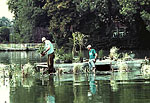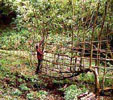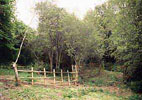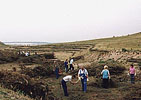 |
n o t e s |
] |
|
| work
'in situ' - B/B : photographies |
catalogue
exhibitions
bibliography
guest artists
current events
contact
work 'in situ' ] |
|
|
I Immediately upon deciding to work together, we chose a field of experimentation independent of our respective activities. We wanted a common and neutral middle-ground, a studio without walls. Sites were to be the frame, or stage, for the dramatization of different relationships: between us, us and others - our partners, the local population, etc. - as well as between us and places that were otherwise forgotten, forsaken, overlooked. Fragments of nature or of the countryside which, finally, were often quite close and familiar. |
|

|
I The B/B art project considers the site with care and makes careful use of it. Our involvement is always geared to a technical-visual solution adapted to each site-situation. The point is to materialize - on a specific spot, and through it - a process of temporary appropriation, the passing possession or transient taming of a place. This is essentially a matter of experience - direct and intense - there is no room for simulation. Site-work is a matter of reacting to a place, so as to activate or inactivate it. This means relying on the givens of the site, interpreting it and its surroundings, considering its history - in ecological terms - so as to adapt to or alter the order of things; the latter being the more critical aspect of our intervention. |
 |
I Following a sort of technical mimesis, our operative modalities are drawn from the local environment and, generally speaking, from the fields of agriculture, architecture, ecology, and photography. There are no trade secrets or special skills. The re-appropriation and re-interpretation of ordinary modes of territorialization - however transient - produce the ordered figures of our respective positions. That is, ways of being-in-the-world and inhabiting it, a co-existence congruent with the facts of the site: weather, schedule, and social modes of adoption and co-adaptation. Our rites of appropriation-inhabiting-dispossession involve the process of emergence and abandonment of a site, a passage, a transitory condition. To tame a piece of land is to try to make it one’s own at the same time that it shapes one - while the co-habitation lasts. It is a drama with three actors: the two of us and a site that is never neutral. |
|
I The finished work demands an active attitude on the part of the spectator. It is an invitation to act/react, not just because of an implicit adherence to the artwork, but because of the experience of the site: frequentation/appropriation. Thus our installations often include footpaths that penetrate the installation and facilitate its occupation. The phase of dispossession heralds that of the social and local disappearance/integration. This involves a tacit contract with the physical and social milieus. |
|
   |
|
|
I In recent years we have been giving special emphasis to developing a greater integration of the spatial, temporal and social factors. The salvaging of sites in the process of losing their meaning involves a social dimension in which spaces are re-activated, in which our critical gaze creates figures not always expected, but that we wish to see emerge. |
|
   |
|
|
I Spatial expansion of the intervention from tens of square meters to hundreds of hectares modifies our relationship to the work: to its size, if not scale. Here, the means require more than ever that we anticipate, work in teams, and organize the construction of specific interventions. Temporal extension from months to decades requires another relationship to the site and the duration of the realization. Site-work enjoins us to take the cyclical dimension of time into consideration: when the maintenance of a site becomes the sine qua non of the existence of our work, but also when other time-frames are involved - years to decades - when the masses in play oppose their inertia to disappearance. |
|
© bruni/babarit
octobre 2001
| |